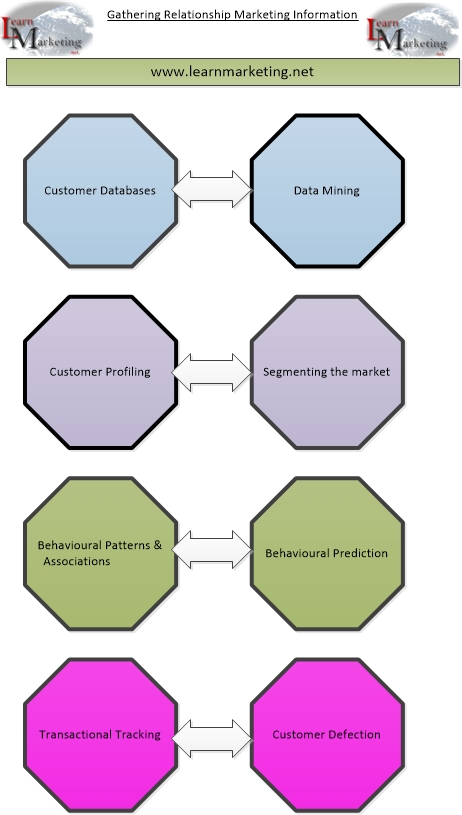Welcome to LearnMarketing.net
Relationship Marketing and Information- Unit 29
Introduction
Relationship Marketing will only be fully successful if the company has been able to collect data on consumer behaviour on their existing and potential customers. Below we look at the different ways data can be collected on customers.
Relationship Marketing And The Use of Data
1. Customer Databases: Databases are essential for relationship marketing. Databases hold information on buying patterns such as expenditure, items purchased, frequency of purchase, time of purchase and a vast array of other information. Often many companies give an incentive to customers to give up this data through signing up to a loyalty scheme or an offer of a 'free gift'. Tesco's clubcard loyalty scheme rewards customers for their purchase but at the same time, collects the above mentioned data on their customers, essential for strategic decision making.
The data collected can help companies target their customers individually, by sending them information or discounts on future related purchases.
2. Data Mining. Once data has been collected it needs to be analysed to identify trends, consumer behaviour and what potential need there maybe. When data is mined iit can also be presented in visual form to make analysing the data more more presentable. Information that is data mined is used for marketing purposes to help the firm develop it's marketing strategy..
3. Customer Profiling and Categorisation. Data that is collected and mined is then used to help the orgnisation 'profile' their target customers. Profiling refers to analysing a persons psychological and behavioual characteristcs in order to predict future behaviours. Understanding this may help a firm establish a relationship with these potential 'profiled' customers.
4. Segmenting the Market. Once customers have been profiled they can then be segmented into different groups. Segmenting is about splitting a consumers into groups that display similar characteristics. Customers can be segmented in many different ways. Macro segmentation is about dividing customers that have one or two similar behaviours , micro segmentation is about finding customers in a group that have a specific need, for example identifying those customers who enjoy fishing as a sport. This is a very specific need.
Once a market has been segmented then a company can focus on developing a relationship marketing strategy amongst their target market.
5. Behavioural Pattern, Association and Predictions. Information that is collected via loyalty cards is then analysed to establish behaviours. If purchase patterns can be established then a firm can better develop a stronger relationship with their customers, past purchase patterns can be analyed to establish if there are any related products that their customers maybe interested in. The data can also be used to try to predict what future puchases a customer will make based on past purchase actions. Amazon are excellent at analysing customer data and sending out targeted promotional material to customers who maybe interested in products based on past purchase behaviours.
6. Transaction Tracking and Follow Through: When a customer purchases a product the systems that proceed after the transaction takes place is really important. The transaction must go through smoothly, customers should have a choice of paying through different methods eg Apple and Google Pay, debit card or credit card. Making the transaction process easier. Having transaction options helps establish relationships with the customer.
There should also be a follow through in terms of asking the customer to take a survey to establish how the transaction process went, was it smooth, where representatives friendly through the transaction process. If the process went through online, the purhase process should be straight forwad and simple.
The customer service after the purchase is usually what seals the deal with relationship marketing. If there is a problem with the product or service, the after sales service should be able to resolve any of these problems. UK retailer John Lewis are well known for their after sales service and have received many retail awards for this, this has enabled John Lewis to develop long-term relationships with their established customers.
7. Customer Defection - Data that is collected and minded will also give information on the number of customers that may leave and go to competitors. This data will help the company analyse why they have left and what is it about the relationsip that did not quiete work. Many companies have retention departments, when customers phone up to leave or switch providers, the host organisation will do their best to try to retain them. It is cheaper to retain exisiting customers then attract new ones.

Conclusion
Analysing relationship marketing data is crucial if the company wants to develop long term relationships with its customers and knowing how to analyse this data is important for long term relationship marketing strategies.




